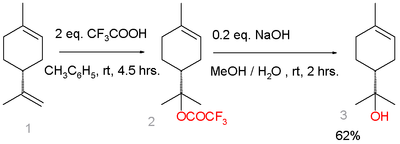Terpineol
| alfa-terpineol | ||
|---|---|---|
 | ||
 | ||
| Nombre IUPAC | ||
| 2-(4-Methyl-1-cyclohex-3-enyl)propan- 2-ol | ||
| General | ||
| Otros nombres |
alpha-Terpineol α-Terpineol p-Menth-1-en-8-ol α,α,4- Trimethylcyclohex-3-ene-1-methanol Terpene alcohol | |
| Fórmula molecular | C10H18O | |
| Identificadores | ||
| ChEBI | 22469 | |
| ChEMBL | 507795 | |
| ChemSpider | 13850142 | |
| UNII | 21334LVV8W | |
|
C\C1=C\CC(CC1)C(O)(C)C
| ||
| Propiedades físicas | ||
| Densidad | 0,9338 kg/m³; 0,0009338 g/cm³ | |
| Masa molar | 154,25 g/mol | |
| Punto de fusión | 306 K (33 °C) | |
| Punto de ebullición | 492 K (219 °C) | |
| Valores en el SI y en condiciones estándar (25 ℃ y 1 atm), salvo que se indique lo contrario. | ||
El terpineol con fórmula química C10H18O, es una forma natural de monoterpeno de alcohol que se ha aislado a partir de una variedad de fuentes tales como el aceite de cajeput, aceite de pino, y aceite petitgrain.[1] Hay cuatro isómeros: alfa-, beta-, gamma-terpineol y terpinen-4-ol. El beta- y el gamma-terpineol difieren solo por la ubicación del doble enlace. El terpineol es por lo general una mezcla de estos isómeros en el que el alfa-terpineol es el componente principal.[cita requerida]
El terpineol tiene un olor agradable similar a la lila y es un ingrediente común en perfumes, cosméticos, y sabores. α-terpineol es uno de los dos más abundantes aromas constituyentes del té lapsang souchong; α-terpineol se origina en el humo de pino utilizado para secar el té.[2]
Aunque es de origen natural, el terpineol es fabricado comúnmente desde el más fácilmente disponible alfa-pineno.
En un estudio, una ruta alternativa a partir del d-limoneno se demostró:[3]

Síntesis de terpineol, a partir de limoneno.
El limoneno reacciona con el ácido trifluoroacético en una reacción de Markovnikov con acetato trifloruro intermedio, el cual se hidroliza fácilmente con hidróxido de sodio a α-terpineol, con 76% de selectividad. Productos adiccionales son el β-terpineol en una mezcla de cis-isomer y 4-terpineol.[cita requerida]
Referencias
[editar]- ↑ Merck Index, 11th Edition, 9103
- ↑ Shan-Shan Yao, Wen-Fei Guo, Yi Lu, Yuan-Xun Jiang (2005). «Flavor Characteristics of Lapsang Souchong and Smoked Lapsang Souchong, a Special Chinese Black Tea with Pine Smoking Process». Journal of Agricultural and Food Chemistry 53 (22).
- ↑ Yuasa, Yoshifumi; Yuasa, Yoko (2006). «A Practical Synthesis ofd-α-Terpineol via Markovnikov Addition ofd-Limonene Using Trifluoroacetic Acid». Organic Process Research & Development 10 (6): 1231. doi:10.1021/op068012d.
Enlaces externos
[editar]- MSDS for alpha-terpineol
 Wikimedia Commons alberga una categoría multimedia sobre Terpineol.
Wikimedia Commons alberga una categoría multimedia sobre Terpineol.- Esta obra contiene una traducción derivada de «Terpineol» de Wikipedia en inglés, publicada por sus editores bajo la Licencia de documentación libre de GNU y la Licencia Creative Commons Atribución-CompartirIgual 4.0 Internacional.
Text is available under the CC BY-SA 4.0 license; additional terms may apply.
Images, videos and audio are available under their respective licenses.

